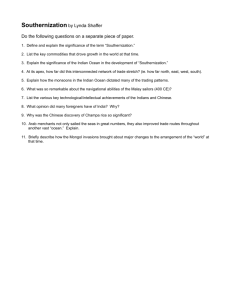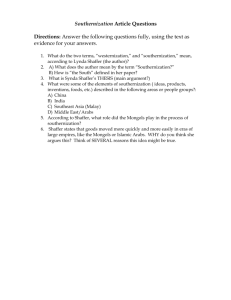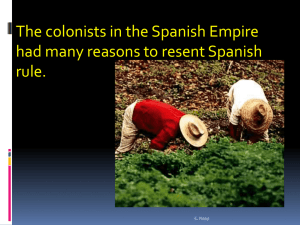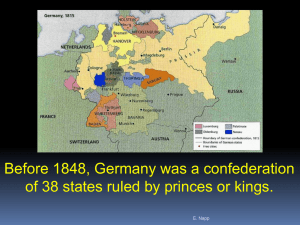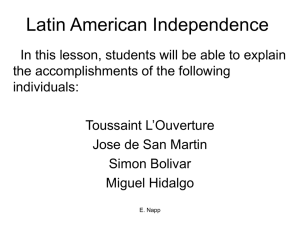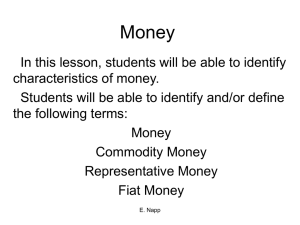Reflections: Southernization - White Plains Public Schools
advertisement
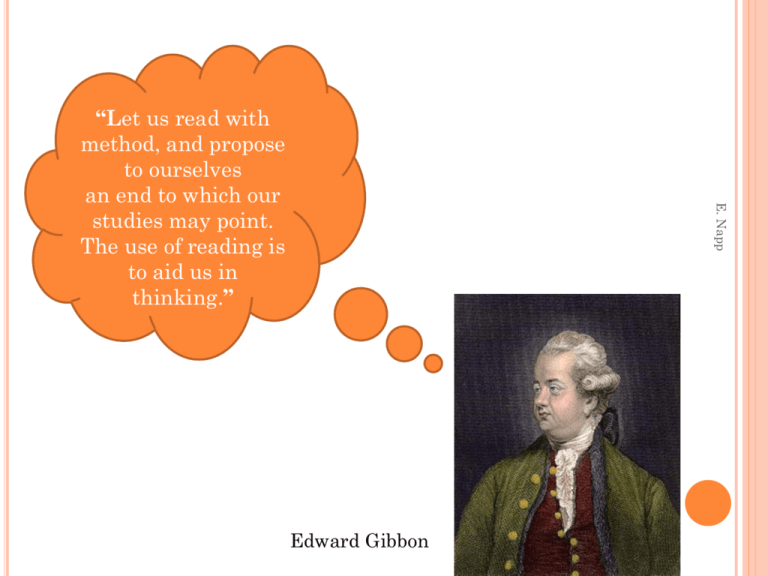
E. Napp “Let us read with method, and propose to ourselves an end to which our studies may point. The use of reading is to aid us in thinking.” Edward Gibbon “SOUTHERNIZATION” Title: “Southernization” Written by Lynda Shaffer Published by Journal of World History, Vol. 5, No. 1 Copyright 1994 by University of Hawaii Press E. Napp REFLECTIONS Ultimately, to read is to think And for every reader, there is a different perspective What follows is a selection of passages that captured this humble reader’s attention E. Napp WHAT IS SOUTHERNIZATION? Southernization is meant to be analogous to westernization Westernization refers to certain developments that first occurred in Europe and then spread to other places Southernization refers to certain developments that first occurred in Southern Asia and then spread to other places It could be argued that by 1200, southernization had created an eastern hemisphere characterized by a rich south and a north that was poor in comparison E. Napp It could also be suggested that in Europe and its colonies, the process of southernization laid the foundations for westernization E. Napp THE INDIAN BEGINNING Southernization was the result of developments that took place in many parts of southern Asia, both on the Indian subcontinent and in Southeast Asia Perhaps the oldest strand in the process was the cultivation of cotton and the production of cotton textiles for export Cotton was first domesticated in the Indus River Valley some time between 2300 and 1760 B.C.E., and by the second millennium B.C.E., the Indians had begun to develop sophisticated dyeing techniques E. Napp Demand for Indian cotton grew as did the trade in Indian textiles The trade in Indian textiles was not undermined until Britain’s Industrial Revolution, when steam engines began to power the production of Indian textiles E. Napp THE SEARCH FOR NEW SOURCES OF BULLION Another strand in the process of southernization, the search for new sources of bullion, can be traced back in India to the end of the Mauryan Empire (321-185 B.C.E.) During Mauryan rule, Siberia had been India’s main source of gold, but nomadic disturbances in Central Asia disrupted the traffic between Siberia and India at about the time that the Mauryans fell Indian soldiers then began to travel to the Malay peninsula Indians introduced this gold to international trade routes E. Napp E. Napp Indian voyages on the Indian Ocean were part of a more general development, more or less contemporary with the Mauryan Empire, in which sailors of various nationalities began to knit together the shores of the “Southern Ocean,” a Chinese term referring to all the waters from the South China Sea to the eastern coast of Africa Sometime before 300 B.C.E., Malay sailors began to ride the monsoons, season winds that blow off the continent of Asia in the colder months and onto the shores in the warmer months These Malay sailors may have been the first to establish contact between Indian and Southeast Asia E. Napp The presence of Malay sailors in East Africa is testified to by the peoples of Madagascar, who still speak a Malayo-Polynesian language And in the last centuries B.C.E., if not earlier, Malay sailors were delivering cinnamon from South China Sea ports to East Africa and the Red Sea E. Napp Malay sailors rode the monsoons without a compass, out of sight of land, and often at latitudes below the equator where the northern pole star cannot be seen They navigated by the wind and the stars, by cloud formations, the color of water, and swell and wave patterns on the ocean’s surface E. Napp It appears that the pepper trade developed after the cinnamon trade In the first century C.E. southern India began supplying the Mediterranean with large quantities of pepper Indian traders and shippers and Malay sailors were also responsible for opening up an all-sea route to China The traders’ desire for silk drew them out into more dangerous waters in search of a more direct way to its source E. Napp Not until the latter parts of the fourth century did the fine spices – cloves, nutmeg, and mace – begin to assume importance on international markets These rare and expensive spices came from the Moluccas, several island groups about a thousand miles east of Java Until 1621, these Moluccan islands were the only places in the world able to produce cloves, nutmeg, and mace in commercial quantities It was also during the time of the Gupta kings, around 350 C.E., that the Indians discovered how to crystallize sugar Though there is disagreement about where sugar was first domesticated, sugar cultivation spread to the Indian subcontinent E. Napp Sugar, however, did not become an important item of trade until the Indians discovered how to turn sugarcane juice into granulated crystals that could be easily stored and transported E. Napp THE FOUNDATION FOR MODERN MATHEMATICS The Indians also laid the foundation for modern mathematics during the time of the Guptas Western numerals, which Europeans called Arabic since they acquired them from the Arabs, actually come from India The most significant feature of the Indian system was the invention of the zero as a number concept The Indian zero made the place-value system of writing numbers superior to all others E. Napp With the zero the Indians were able to perform calculations rapidly and accurately and to discern mathematical relationships more aptly These numerals and the mathematics that the Indians developed with them are now universal – just one indication of the global significance of southernization As a result of these developments India acquired a reputation as a place of marvels, a reputation that was maintained for many centuries after the Gupta fell E. Napp SOUTHERNIZATION OF CHINA These Southern Asian developments began to have a significant impact on China after 350 C.E. The Han dynasty had fallen in 221 C.E., and for more than 350 years thereafter China was ruled by an ever changing collection of regional kingdoms During these centuries, Buddhism became increasingly important in China, Buddhist monasteries spread throughout the disunited realm, and cultural exchange between India and China grew accordingly E. Napp By 581, when the Sui dynasty reunited the empire, processes associated with southernization had already had a major impact on China The process of southernization continued during the Tang (618-906) and Song (960-1279) dynasties One might even go so far as to suggest that the process of southernization underlay the revolutionary social, political, and technological developments of the Tang and Song The Chinese reformed their mathematics but did not adopt Indian numerals at that time Cotton and indigo became well established, giving rise to the blue-black peasant garb that is still omnipresent in China E. Napp Southernization in China also led to the introduction of new varieties of rice The most important of these was what the Chinese called Champa rice, since it came to China from Champa, a Malay kingdom located on what is now the southeastern coast of Vietnam Champa rice was a drought-resistant, early ripening variety that made it possible to extend cultivation up well-watered hillsides, thereby doubling the area of rice cultivation in China E. Napp E. Napp Before the process of southernization, northern China had always been predominant, intellectually, socially, and politically But by 600, southern China was well on its way to becoming the most prosperous and most commercial part of the empire The most telling evidence for this is the construction of the Grand Canal, which was completed around 610, during the Sui dynasty This dynasty felt a need to build a canal that could deliver southern rice to northern cities The Tang dynasty, when Buddhist influence in China was especially strong, saw two exceedingly important technological innovations – the invention of printing and gunpowder These developments may also be linked to southernization as printing seems to have developed within the walls of Buddhist monasteries between 700 and 750 and the invention of gunpowder in China by Daoist alchemists in the ninth century may also be related to the linkages between India and China created by Buddhism E. Napp By the time of the Song the Chinese had also perfected the “south-pointing needle,” otherwise known as the compass Once the Chinese had the compass they, like Columbus, set out to find a direct route to the spice markets of Java and ultimately to the Spice Islands in the Moluccas Unlike Columbus, the Chinese found them Cities on China’s southern coast became centers of overseas commerce Silk remained an important export, and by the Tang dynasty it had been joined by a true porcelain, which was developed in China sometime before 400 C.E. E. Napp China and its East Asian neighbors had a monopoly on the manufacture of true porcelain until the early eighteenth century China’s southern ports were also exporting to Southeast Asia large quantities of ordinary consumer goods, including iron hardware, such as needles, scissors, and cooking pots Until the British Industrial Revolution of the eighteenth century, no other place ever equaled the iron production of Song China E. Napp THE RISE OF ISLAM In the seventh century C.E. Arab cavalries, recently converted to Islam, conquered eastern and southern Mediterranean shores that had been Byzantine (and Christian), as well as the Sassanian empire (Zoroastrian) in what is now Iraq and Iran In the eighth century they went on to conquer Spain and Turko-Iranian areas of Central Asia, as well as northwestern India Once established on the Indian frontier, they became acquainted with many elements of southernization E. Napp The Arabs were responsible for the spread of many important crops, developed or improved in India, to the Middle East, North Africa, or Islamic Spain Among the most important were sugar, cotton, and citrus fruits The Arabs were the first to import large numbers of enslaved Africans to produce sugar Fields in the vicinity of Basra were the most important sugar-producing areas within the caliphate, but before this land could be used, it had to be desalinated To accomplish this task, the Arabs imported East African (Zanj slaves) but in 869, the Zanj slaves rebelled It took the caliphate fifteen years to defeat them and thereafter Muslim owners rarely used slaves for purposes that required concentration in large numbers E. Napp The introduction of Indian crops, such as sugar and cotton, led to a much more intensive agriculture in the Middle East and some parts of the Mediterranean Under Arab auspices, Indian mathematics followed the same routes as crops Al-Kharazmi (ca. 780 – 847) introduced Indian mathematics to the Arabic-reading world in his Treatise on Calculation with the Hindu Numerals, written around 825 On this foundation, Muslim scientists made remarkable advances in algebra and trigonometry The Arab conquests also led to an increase in long-distance commerce and the “discovery” of new sources of bullion E. Napp Soon after the Abbasid caliphate established its capital at Baghdad, Arab ships were plying the maritime routes from the Persian Gulf to China By the ninth century, they had acquired the compass (in China, most likely) And they may well have been the first to use it for marine navigation, since the Chinese do not seem to have used it for this purpose until after the tenth century E. Napp After the conquest of North Africa, Arabs discovered that gold came across the Sahara, and they became intent on going to Ghana, its source Thus it was that the Arabs “pioneered” or improved an existing long-distance route across the Sahara, an ocean of sand rather than water The Arabs prompted an expansion of trade across the Sahara E. Napp SOUTHERNIZATION OF THE EUROPEAN MEDITERRANEAN By 1200 the process of Southernization had created a prosperous south from China to the Muslim Mediterranean But the grandest conquerors of the thirteenth century were the Central Asians Turkish invaders established the Delhi sultanate in India Mongolian cavalries devastated Baghdad, the seat of the Abbasid caliphate since the eighth century, and they captured Kiev, further weakening Byzantium E. Napp By the end of the century, the Mongols had captured China, Korea, and parts of mainland Southeast Asia as well Because the Mongols were pagans at the time of their conquests, the western Europeans cheered them on as they laid waste to one after another Muslim center of power in the Middle East Many places that had flourished were toppled, and power gravitated to new locales Yet at the same time the Mongols’ control of overland routes between Europe and Asia led in the thirteenth and fourteenth centuries to unprecedented contacts between Europeans and peoples from those areas that had long been southernized E. Napp Marco Polo’s long sojourn in Yuan Dynasty China is just one example of such interaction Under the Mongols overland trade routes in Asia shifted north and converged on the Black Sea After the Genoese helped the Byzantines to retake Constantinople from the Venetians in 1261, the Genoese were granted special privileges of trade in the Black Sea Italy then became directly linked to the Mongolian routes Such contacts contributed to the southernization of the Christian Mediterranean during this period of Mongolian hegemony Although European conquerors had sometimes taken over sugar and cotton lands in the Middle East during the Crusades, not until some time after 1200 did European-held Mediterranean islands become important exporters E. Napp Also after 1200 Indian mathematics began to have a significant impact in Europe Indian numerals and mathematics did not become important in western Europe until the thirteenth century, after the book Liber abaci (1202), written by Leonardo Fibonacci of Pisa (ca. 1170-1250), introduced them to the commercial centers of Italy The Europeans also first acquired the compass, printing, and gunpowder during this time of hemispheric reorganization Yet another consequence of the increased traffic and communication on the more northern trade routes traversing the Eurasian steppe was the transmission of the bubonic plague from China to the Black Sea E. Napp The plague had broken out first in China in 1331, and apparently rats and lice infected with the disease rode westward in the saddlebags of Mongolian post messengers, horsemen who were capable of traveling one hundred miles per day E. Napp During the latter part of the fourteenth century the unity of the Mongolian empire began to disintegrate, and new regional powers began to emerge in its wake Throughout much of Asia the chief beneficiaries of imperial disintegration were Turkic or TurkoMongolian powers of the Muslim faith The importance of Islam in Africa was also growing at this time, and the peoples of Southeast Asia, from the Malay peninsula to the southern Philippines, were converting to the faith Indeed, the most obvious dynamic in the centuries before Columbus was the expansion of the Islamic faith E. Napp Under Turkish auspices Islam was even spreading into eastern Europe, a development marked by the Ottoman conquest of Constantinople in 1453 This traumatic event lent a special urgency to Iberian expansion The Iberians came to see themselves as the chosen defenders of Christendom Ever since the twelfth century, while Christian Byzantium had been losing Anatolia and parts of southeastern Europe to Islam, they had been retaking the Iberian peninsula for Christendom E. Napp One way to weaken the Ottomans and Islam was to go around the North African Muslims and find a new oceanic route to the source of West African gold Before the Portuguese efforts, sailing routes had never developed off the western shore of Africa, since the winds blow in the same direction all year long, from north to south Yes, earlier Europeans could have gone to West Africa, but they would not have been able to return home The Portuguese success would have been impossible without the Chinese compass E. Napp The Portuguese success would also have been impossible without Arabic tables indicating the declination of the noonday sun at various latitudes and the lateen sail, which was also an Arab invention E. Napp The Portuguese caravels were of mixed, or multiple, ancestry, with a traditional Atlantic hull and a rigging that combined the traditional Atlantic square sail with the lateen sail of Southern Ocean provenance With the lateen sail the Portuguese could tack against the wind for the trip homeward E. Napp The new route to West Africa led to Portugal’s rounding of Africa and direct participation in Southern Ocean trade E. Napp While making the voyages to West Africa, European sailors learned the wind patterns and ocean currents west of Africa, knowledge that made the Columbian voyages possible The Portuguese moved the sugarcane plant from Sicily to Madeira, in the Atlantic, and they found new sources of gold, first in West Africa and then in East Africa Given that there was little demand in Southern Ocean ports for European trade goods, they would not have been able to sustain their Asian trade without this African gold E. Napp THE RISE OF EUROPE’S NORTH The rise of the north, or more precisely, the rise of Europe’s northwest, began with the appropriation of those elements of southernization that were not confined by geography In the wake of their southern European neighbors, they became partially southernized, but they could not engage in all aspects of the process due to their distance from the equator E. Napp Full southernization and the wealth that we now associate with northwestern Europe came about only with their outright seizure of tropical and subtropical territories and their rounding of Africa and participation in Southern Ocean trade E. Napp E. Napp In the West Indies and along the coast of South America, the Dutch, the French, and the English acquired lands where for the first time they were able to become producers of sugar and cotton, though with African labor on Native American land In West Africa the Dutch seized the Portuguese fort at Elmina, Portugal’s most important source of gold And in the East Indies, the Dutch seized Portuguese trading posts in the Moluccas and in 1621 conquered the Banda Islands, thereby gaining a stranglehold on the fine spices Without such southern possessions the more northern Europeans had been unable to participate fully in the southernization process, since their homelands are too far north to grow either cotton or sugar, much less cinnamon, pepper, or the fine spices E. Napp Europe began its rise only after the thirteenthcentury reorganization of the Eastern Hemisphere facilitated its southernization, and Europe’s northwest did not rise until it too was reaping the benefits of southernization Indeed Europe’s rise should be portrayed as one part of a hemisphere-wide process, in which a northwestern Europe ran to catch up with a more developed south – a race not completed until the eighteenth century E. Napp Southernization began as a Southern Asian phenomenon and spread through the warmer latitudes of the Eastern Hemisphere north of the equator Both in China and in the Middle East it stimulated new developments and acquired new elements, and its potential continued to unfold After 1200 the radical transformations throughout the Eastern Hemisphere brought about by the Mongolians and many others created conditions that led to the spread of southernization to Europe and Europe’s colonies in the Western Hemisphere Southernization was not overtaken by westernization until the Industrial Revolution of the eighteenth century E. Napp E. Napp Only after the northwestern Europeans had added to their own repertoire every one of the elements of southernization did the world become divided into a powerful, prestigious, and rich north, and an impoverished south perceived to be in need of development
